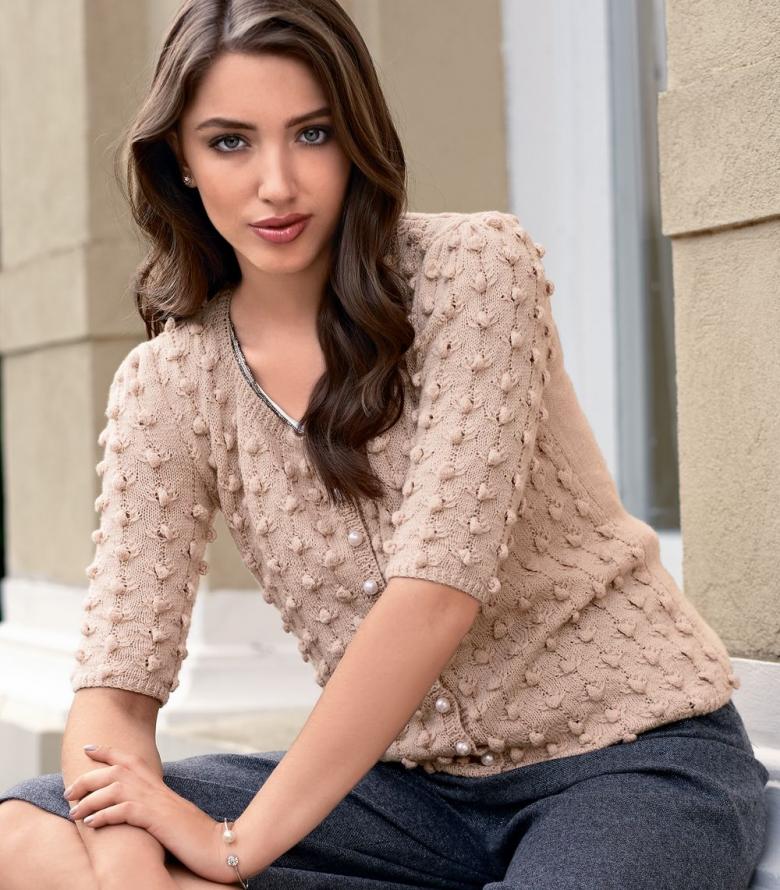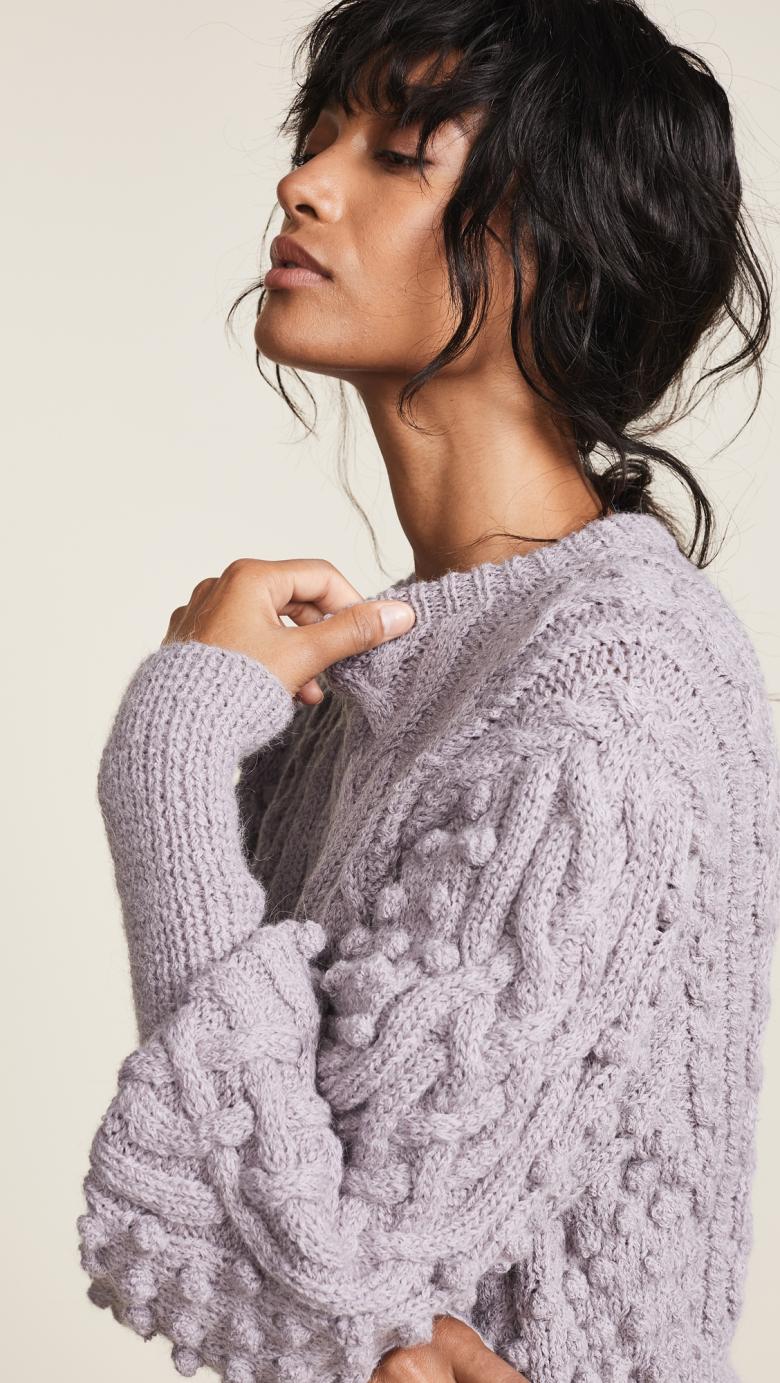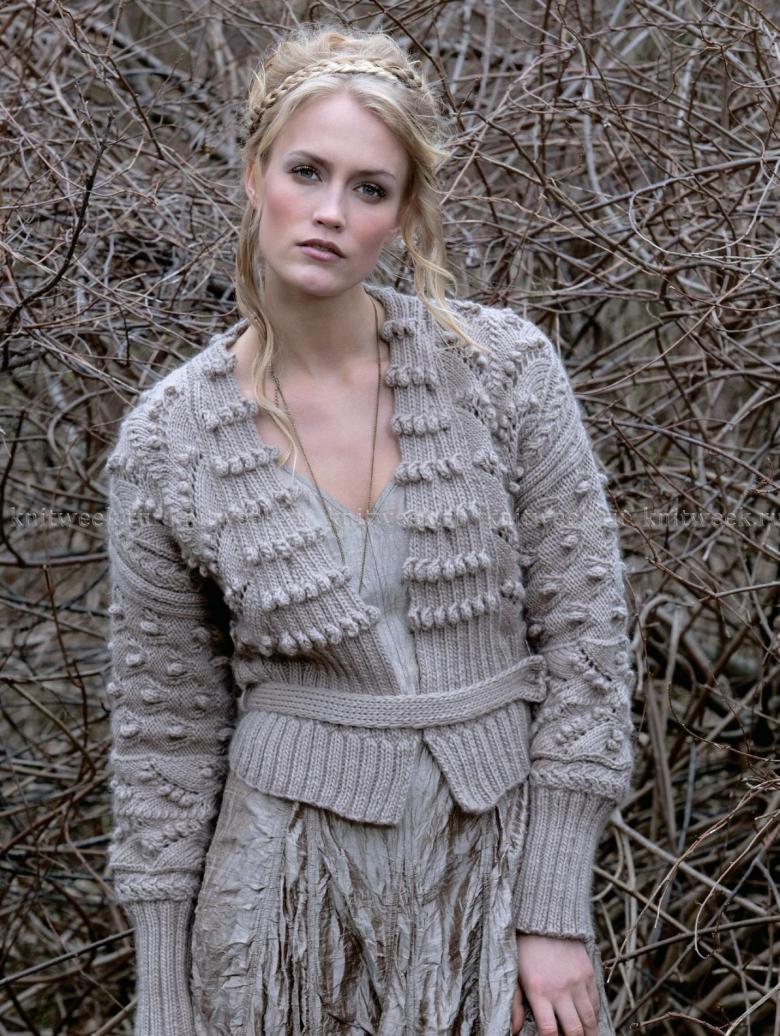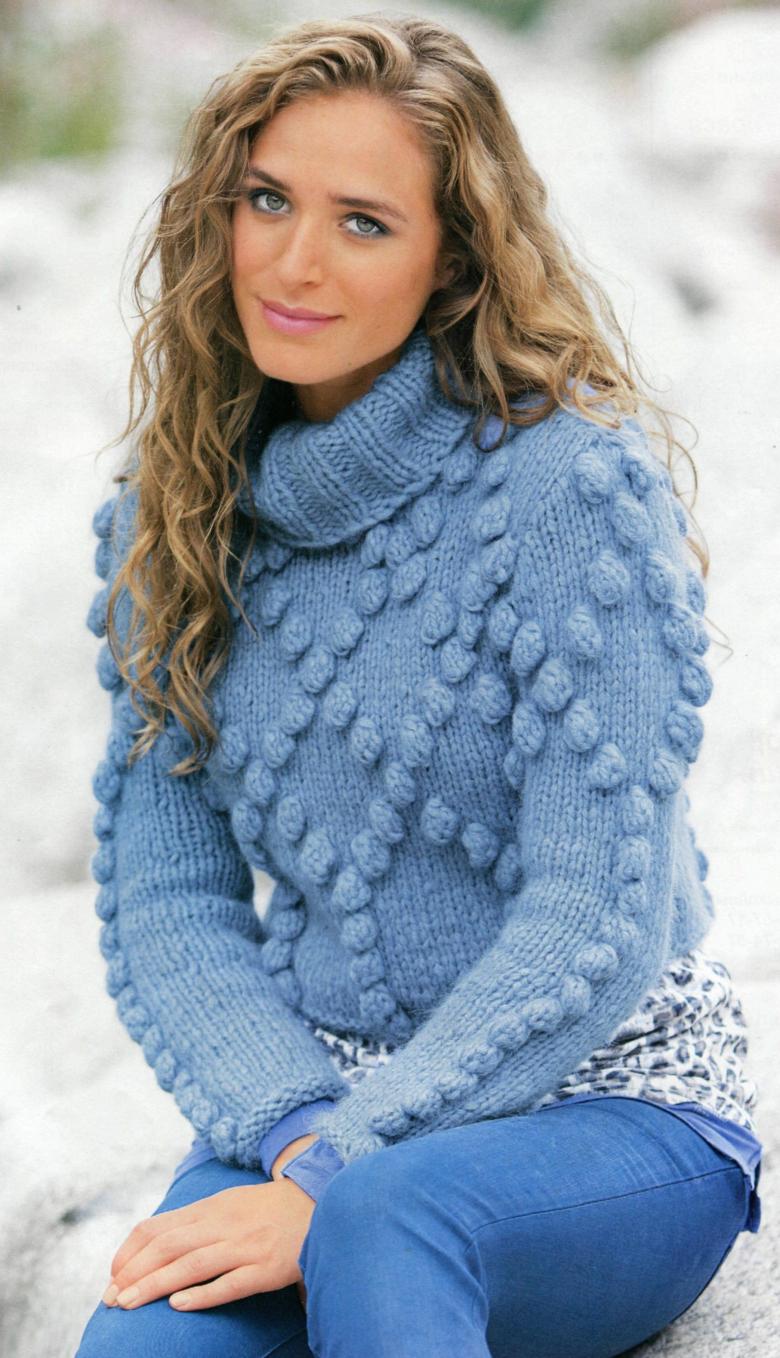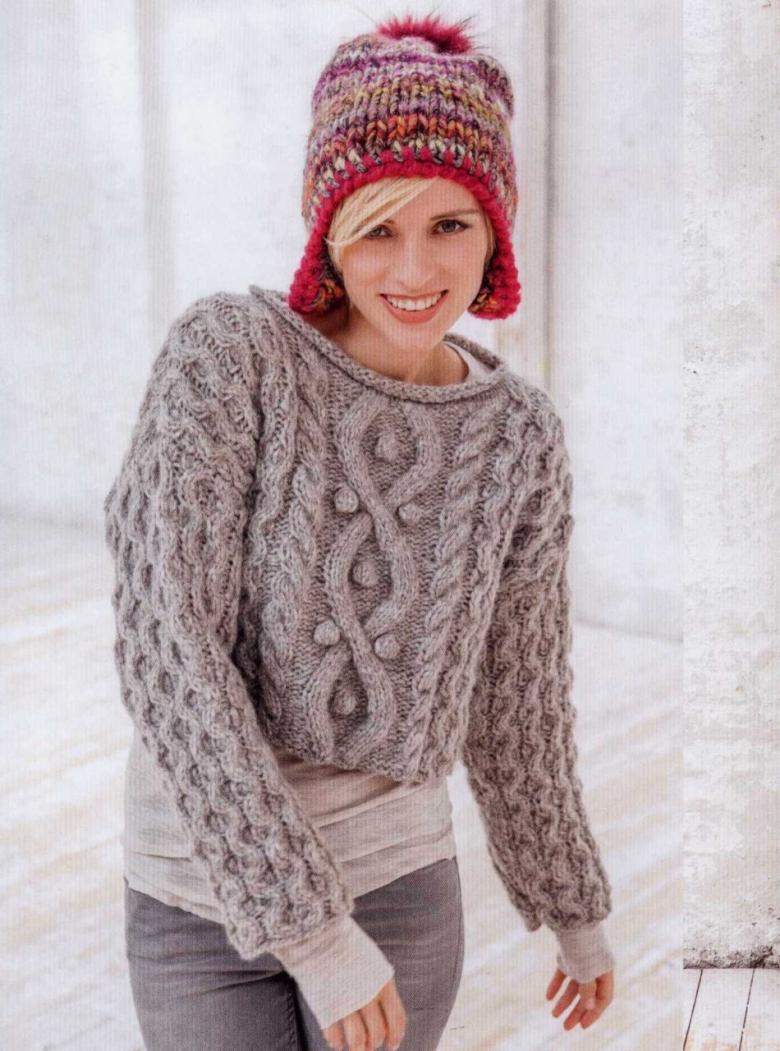The knitting pattern of cones in spits - a detailed description of the scheme, photo examples, especially the practical application
In today's world, where stores offer an almost identical range of accessories and clothes, you want to stand out more than usual. Those who know how to use needles in this situation are lucky - you have a unique opportunity to design your own things.

One of these ways is to choose a unique ornament, which is "cone". It belongs to the category of relief patterns and is used mainly with shawl or stocking knitting. However, this can also be combined with convex rhombuses, braids. And even with ajour.

"The bobbin is a universal ornament and is suitable for any type of clothing. The most profitable use is for sweaters, vests, and scarves.
Technology of knitting the pattern
The final shape of the cone itself and the way of knitting depends solely on the taste of the craftswoman. However, before you start working on different patterns, you should master the basic knitting technology.

It is always based on 3 or 5 loops. One buttonhole is used for knitting, for example, five by doing a right, and then a cast-off is made. The original buttonhole is then discarded. The loops are then tied on the wrong side, and then five loops are tied together, but again on the right side. By increasing the number of rows you can adjust the size. For a larger size, you have to knit in the 6th or 7th row.

Examples of patterns
How to knit a hazelnut?
The hazelnut is a convex semicircle that really looks like a large nut. To create such an ornament, the number of selected stitches must be a multiple of five. Add 4 more to the total number and add the stitches.
- In the first row we are doing 4 stitches, then from one stitch we are doing also 4 stitches in the sequence from right-blank-left-blank, and again 4 stitches in the wrong side.
- In the second and fourth rows, 4 in, 4 out, 4 in, 4 out.
- In the third row, it is 4 in, 4 out, 4 in.
- In the fifth - 4 in, 4 together in, 4 out.
- In the sixth and eighth rows, only straight stitches.
- In the seventh, only inside.
- In the ninth repeat the sequence of the first row.

The same method can be used for a simpler "cedar nuts" pattern. To do this, the typed loops should be a multiple of four. Add three more to them, add the endings.
- In the first row, we do three on the wrong side, a face, a cast-off, a cast-off, a cast-off, a face, three on the wrong side, a cast-off, a cast-off, a cast-off, a cast-off.
- In the second line make 3 faces, then five stitches together on the wrong side and 3 faces.
- The third, sixth, and seventh lines are straight. The fourth, fifth, and eighth are on the wrong side.
- The ninth row repeats the scheme of the first.

How to create a openwork pattern (with needles)?
For the openwork pattern, the number of stitches should be a multiple of 10 with the addition of the stitches. The scheme is as follows:
- In the first one, make a back stitch, a cast-off, 3 of the wrong stitches, 3 of the wrong stitches together, 3 of the wrong stitches, a cast-off, a wrong stitch, a cast-off, 3 of the wrong stitches, 2 of the wrong stitches together, a wrong stitch to the right.
- In the second, first, a face stitch, then a cast-off, then 3 faces, 3 faces together, again 3 faces, a cast-off, a cast-off, a cast-off, 3 faces, 2 faces together to the right.
- The third row repeats the first.
- The fourth is the second.
- In the fifth we knit 2 stitches together to the right, 3 sevens, a cast-off, a cast-off, 3 sevens, 3 sevens together, again 3 sevens, a cast-off, a cast-off, a cast-off.
- In the sixth stitch we knit 2 stitches together to the right, 3 stitches together to the right, 3 stitches together to the right, 3 stitches together to the right. stitches, a hinge, a front, a hinge, three faces, three faces together, three faces again, a hinge, a front.
- The seventh repeats the fifth.
- The eighth is the sixth.
- The ninth is the first.

Practical application of the "bobbin" pattern - accessories for women
Before you start creating a piece of clothing, you should master the technology of knitting. Only then get to create things like the photos in fashion magazines. The easiest way to start with a hat.

Specify the size of the hat and pick up the needles. For example, a size 57 hat - size 6 needles.
For such a hat will need 62 loops. You should knit in two rows and use a shawl pattern. It means that first the stitches will go from the front side, and then from the wrong side.

After that, the following algorithm should be repeated:
- In the first row, we do 3 face loops, 1 to the wrong side, then we do a cast on, take off without a tie, then we do together a wrong side, then just a wrong side.
- In the second, fourth, etc. 3 wrongs, 1 right, a left, then a wrong without a wrong, then a right.
- In the third row we do 3 straight loops, 1 back, 1 front with a stitch, and 1 back.
All remaining rows repeat the stitches alternating between the second and third rows.

On 10 rows, add a bobbin in the patent columns, knit using a staggered order. Knit 4 loops on the right and wrong side alternately and one, then turn the work over and knit 4 wrong loops. Go back to the front and knit 4 stitches.

When the height of the hat will reach 15-16 centimeters, you must begin to reduce the number of loops. Accordingly, in the scheme should be soldering 2 obverse together instead of 3 obverse loops. This scheme is followed for another 10 rows, and the remaining loops, beginning with the eleventh row, we will knit in the same amount to the fifteenth row. As soon as the last row is reached, use a yarn to fasten it, thus pulling the loops down. To give the hat a more elegant shape, add a pompom or a ball to the top.

However, this is not the end of the work. To make the lesson worthwhile, use the following tips.
- First, keep an eye on the wool content of the yarn. The norm is more than 50%.
- Second, avoid steaming. In the process of steaming cones will crumple, lose their shape, and the ornament will be hopelessly spoiled.
- Thirdly, to make an ornament, try to knit with a yarn of a different color. Particularly advantageous to the cone will emphasize the contrasting shades of cloth, but do not forget about the first point. The yarn should by no means be of inferior quality.

Embellishment is not limited to just the cones. The pattern itself can be highlighted by sewing to the cones of different shapes and sizes of beads, sequins, or using, for example, beads. They can be used not only on a plain cloth, but also combined with other ornaments. The most advantageous combination is with rhombuses or braids.
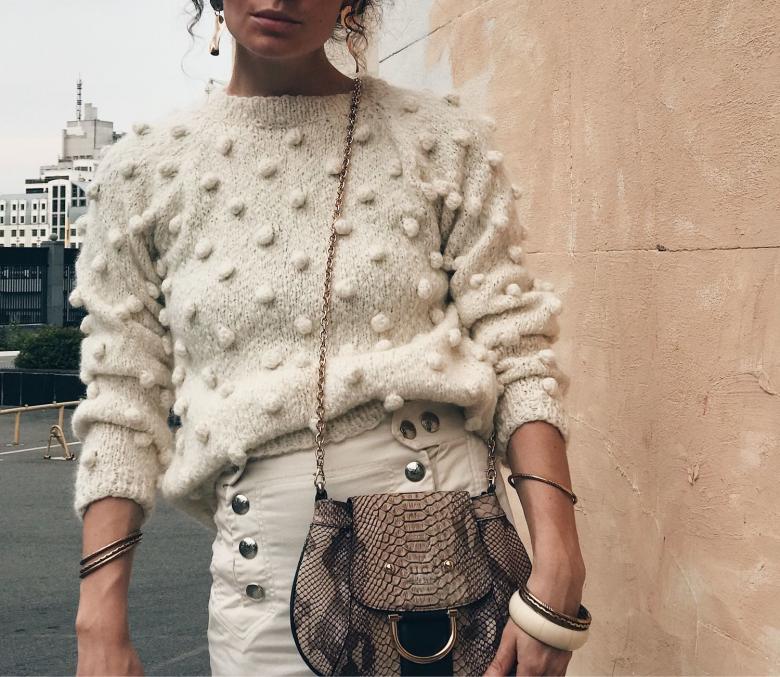
The use of cones in practice is not as difficult as it may seem at first. A little practice in knitting technology, you can create unique closet items that will add your image of liveliness and a little childish spontaneity, and children will delight you.








